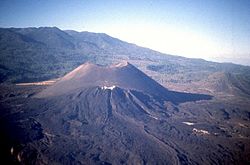Cinder and ash cones
Cinder and ash cones are a type of volcano made of pyroclastic material and are therefore collectively also called pyroclastic cones . They usually only reach a height of ten to a few hundred meters with a diameter of at most a few hundred meters and are therefore much smaller than the more well-known stratovolcano and shield volcanoes . They almost always have a regular conical shape with steep flanks and a blunt tip. As flank volcanoes , they often populate the slopes of large volcanoes such as B. Etna .
Cinder cone
Cinder ( English cinder cone or scoria cone ) consist of loosely stacked Tephra , which is held together only by gravity. Depending on the diameter of the slag, their flanks typically have an angle of 33 °.
If only loose material is extracted from volcanic chimneys, the coarse fragments accumulate in a wall around the chimney and build up the cinder cone. They are the most common volcanoes on the continents, in Central Europe they are known from the Eifel . The profile of such a cone is determined by the maximum slope angle at which the debris is still stable without sliding down the slope. The larger fragments falling close to the summit can form very steep and stable slopes. The finer particles are carried further away from the chimney and lead to gentler slopes at the base of the cone. The classic concave volcanic cone with its central chimney at the summit shows this change in the shape of the slope.
Examples are the Paricutín in Mexico and the Sunset Crater in Arizona.
Welding slag cone

Welding cinder cones (English spatter cone ) are composed of larger lapilli and volcanic bombs . These components are large enough to end up close to the melting temperature after being ejected and thus to stick together to form welding slag on impact . The flanks of a welding slag cone are often much steeper than those of a slag cone.
Examples are the Puʻu ʻŌʻō on Kīlauea on Hawaiʻi and the Eldborg on Iceland.
Hydrovolcanic cones
Ash cone
Cinder Cone (Engl. Ash cone ) can at phreatomagmatic explosions occur when rising magma with groundwater , melting or sea water comes in contact. The explosively resulting water vapor shatters the surrounding rock into volcanic ash , which is deposited in a cone shape around the volcanic chimney in small and very small eruptions . Solidified into rock ( tuff ) by pressure over geological periods of time , they are known as tuff cones . The eruption force is low in these eruptions, the material is typically ejected at a relatively shallow angle, so that the volcanic cone has a low profile and only a low height.
One example is the Bárcena tuff cone on the San Benedicto island, part of Mexico .
Tuff ring
Also Tuffringe (Engl. Tuff ring ) are as tuff cone created by phreatomagmatic explosions. But they are lower than this and have flatter angles of approach, typically less than 25 degrees. With a large diameter in relation to the height and a large flat crater, they show the typical ring structure.
Examples of tuff rings are Hverfjall in Iceland and Diamond Head (Hawaii) .
literature
- Hans-Ulrich Schmincke: Vulcanism . Scientific Book Society, Darmstadt 2000, ISBN 3-534-17471-2 .
- Press / Siever: General Geology . Springer Verlag, Berlin-Heidelberg 2008, ISBN 978-3-8274-1812-8 .
Web links
Photos and videos
Scientific contributions
- Pyroclastic Cones in the Global Volcanism Program (English)
- V. Camp: Scoria cones , How Volcanoes Work , Dept. of Geological Sciences, San Diego State University (English)
- Cinder cone in the mineral atlas
- University of California Press: Volcanology and Geothermal Energy. Chap. 6, Scoria cones and tuff rings (English)
- Carsten Riedel: EU-RTN project on cinder cone formation , Blog Tough-cone , Projects (English)
- Jack Share: Anatomy of a Cinder Cone Roadcut in the Land of Cochise and Its Tale of Farallon Plate Geo Gymnastics - Part I , Blog Written in stone ... seen through my lens (English)
Individual evidence
- ↑ John P. Lockwood, Richard W. Hazlett: Volcanoes - Global Perspectives. John Wiley and Sons, 2010, ISBN 978-1405162500 , pages 296 f. in Google Book Search




